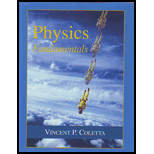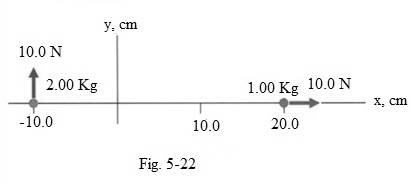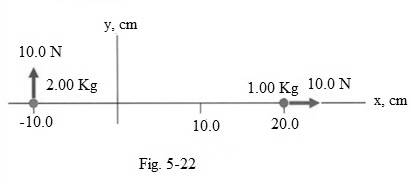
Concept explainers
(a)
To Evaluate: The position of center of mass at

(a)
Answer to Problem 34P
The position of center of mass of particles is
Explanation of Solution
Given:
The time
Formula used:
The x-coordinate of center of mass of particles shown in the figure can be calculated by the following formula:
Where
Similarly the y-coordinates can also be calculated:
Where
Calculation:
When
Substituting
Conclusion:
At
(b)
To Evaluate: The resultant force acting on the system, wherein the location of two particles, which are initially at rest, is shown in Fig. 5-22, and each particle is subject to a constant force, as indicated.

(b)
Answer to Problem 34P
System’s resultant force is calculated as
Explanation of Solution
Given:
The magnitude of the force acting on
The magnitude of force acting on
Formula used:
Formula for the resultant force
Where
Calculation:
The resultant force is being calculated as:
Conclusion:
Thus, the system’s resultant force
(c)
To Evaluate: The location of center of mass at

(c)
Answer to Problem 34P
At
Explanation of Solution
Given:
The magnitude of the force acting on
The magnitude of force acting on
Formula used: It is known that
Where
The x-coordinate of center of mass of particles shown in the figure can be calculated by the following formula:
Where
Similarly the y-coordinates can also be calculated:
Where
Calculation:
As a constant force is acting on each particle, the acceleration of particle
Substituting
Position of particle
When the particle is at rest the velocity
Substituting
Similarly the acceleration of
Substituting
And position of
Substituting values of
At
Substituting
Similarly the y-coordinate of center of system’s mass is calculated at
Substituting
The
Conclusion:
Thus, the location of center of mass at
Want to see more full solutions like this?
Chapter 5 Solutions
Physics Fundamentals
- The position of a particle according to the appropriate coordinate set can be vectorially specified in meters as r = i(sin2nt) – 16j(1 – e-t/4) + kt² /4 where t is the movement time of particle in seconds after passing its origin. If the mass of the particle is 2 kg, calculate the x component of its R force and the magnitude of its resultant force R at time t = 4s.arrow_forwardIn the amusement park ride known as Magic Mountain Superman, powerful magnets accelerate a car and its riders from rest to 45m/s (about 100mi/h) in a time of 7.0s. The combined mass of the car and riders is 5.5×103kg. Find the average net force exerted on the car and riders by the magnets.arrow_forwardYou have been called to testify as an expert witness in a trial involving a head-on collision. Car A weighs 1515 lb and was traveling eastward. Car B weighs 1125 lb and was traveling westward at 43.0 mph. The cars locked bumpers and slid castward with their wheels locked for 18.5 ft before stopping. You have measured the coefficient of kinetic friction between the tires and the pavement to be 0.750. What speed (in miles per hour) was car A traveling just before the collision? (This problem uses English units because they would be used in a U.S. legal proceeding.) UF mpharrow_forward
- If a 0.50-kg block initially at rest on a frictionless, horizontal surface is acted upon by a force of 3.4 N for a distance of 2.3 m, then what would be the block's velocity?arrow_forwardA barefoot field-goal kicker imparts a speedof 27 m/s to a football initially at rest.If the football has a mass of 0.59 kg and thetime of contact with the ball is 0.034 s, whatis the magnitude of the force exerted by theball on the kicker’s foot?Answer in units of N.arrow_forwardA block of mass M slides down a frictionless plane inclined at an angle θ with the horizontal. The normal reaction force exerted by the plane on the block is directed parallel to the plane in the same direction as the movement of the block. parallel to the plane in the opposite direction as the movement of the block perpendicular to the plane. toward the center of the Earth.arrow_forward
- (b) A block of mass 3.00 kg is moving in the positive x direction, across a rough surface (UK-0.11) with an initial velocity of 6.00 m/s and is acted upon by a force FA-4.00, applied in the negative x direction. (b) Identify all the non-conservative forces acting on the mass. Select 2 correct answer(s) OWarrow_forwardA constant horizontal force of 37 N pushes a 20 kg mass through a medium that resists its motion with .9 N for every meter per second of speed. The initial velocity of the mass is 7 meters per second in the direction opposite of the applied force. Find the velocity of the mass after 25 seconds.arrow_forwardA baseball catcher is catching a fastball that is thrown at 43 m/s (96 mi/h) by the pitcher. If the mass of the ball is 0.15 kg and if the catcher moves his mitt backward toward his body by 8.0 cm as the ball lands in the glove, what is the magnitude of the average force acting on the catcher's mitt? Estimate the time interval required for the catcher to move his hands.arrow_forward
- On a body of mass m that is in a smooth horizontal plane began to act at the time t = 0 a force that depends on time according to the law F = ct, where c is a constant. The direction of this force constantly forms an angle a with the horizontal direction, calculate: a) The velocity of the body at the moment of separation from the plane b) The body's journey at this moment. F m ANS mg? cos a a) v = 2c sin? a m²g³ cos a b) s = 2c² sin³ aarrow_forwardThe robot moves the particle A (mass M) in the vertical plane using polar coordinate formulas r(t) = 1,2-0,6sin(2πt) [m] θ(t) = 0,5-1,5cos(2πt) [rad]' in accordance with. Determine the force acting on the object in the θ-direction [N] at time t0 = 1.9 s The mass of the piece is 4.54 kg Use units [N] GIVE ANSWER TO THREE DECIMALSarrow_forwardA force acts for 0.1s on a body of mass 2kg initially at rest. The force is then withdrawn and the body moves with a velocity of 2m/s. Find the magnitude of force.arrow_forward
 College PhysicsPhysicsISBN:9781305952300Author:Raymond A. Serway, Chris VuillePublisher:Cengage Learning
College PhysicsPhysicsISBN:9781305952300Author:Raymond A. Serway, Chris VuillePublisher:Cengage Learning University Physics (14th Edition)PhysicsISBN:9780133969290Author:Hugh D. Young, Roger A. FreedmanPublisher:PEARSON
University Physics (14th Edition)PhysicsISBN:9780133969290Author:Hugh D. Young, Roger A. FreedmanPublisher:PEARSON Introduction To Quantum MechanicsPhysicsISBN:9781107189638Author:Griffiths, David J., Schroeter, Darrell F.Publisher:Cambridge University Press
Introduction To Quantum MechanicsPhysicsISBN:9781107189638Author:Griffiths, David J., Schroeter, Darrell F.Publisher:Cambridge University Press Physics for Scientists and EngineersPhysicsISBN:9781337553278Author:Raymond A. Serway, John W. JewettPublisher:Cengage Learning
Physics for Scientists and EngineersPhysicsISBN:9781337553278Author:Raymond A. Serway, John W. JewettPublisher:Cengage Learning Lecture- Tutorials for Introductory AstronomyPhysicsISBN:9780321820464Author:Edward E. Prather, Tim P. Slater, Jeff P. Adams, Gina BrissendenPublisher:Addison-Wesley
Lecture- Tutorials for Introductory AstronomyPhysicsISBN:9780321820464Author:Edward E. Prather, Tim P. Slater, Jeff P. Adams, Gina BrissendenPublisher:Addison-Wesley College Physics: A Strategic Approach (4th Editio...PhysicsISBN:9780134609034Author:Randall D. Knight (Professor Emeritus), Brian Jones, Stuart FieldPublisher:PEARSON
College Physics: A Strategic Approach (4th Editio...PhysicsISBN:9780134609034Author:Randall D. Knight (Professor Emeritus), Brian Jones, Stuart FieldPublisher:PEARSON





